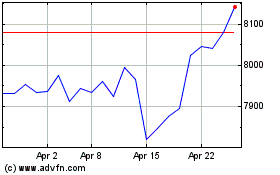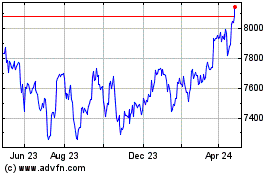By William Watts, MarketWatch
Emerging-market worries resonate after long run of economic
growth and strong markets
As if global trade spats weren't exciting enough, August has
defied its sleepy reputation to bring investors a taste of an
old-fashioned currency crisis in Turkey.
The underlying worry is that other countries that, like Turkey,
heavily rely on external financing in currencies other than their
own are vulnerable to a continued rise in the U.S. dollar could
begin to face trouble, causing problems for financial institutions
that hold that foreign-denominated debt.
"I think we're far from that right now, but I think it weighs on
investors' minds," said Michael Arone, chief investment strategist
at State Street Global Advisors, in a phone interview.
Indeed, Wall Street analysts and economists don't seem overly
afraid that Turkey's woes will morph into a global crisis that will
threaten U.S. economic growth or corporate earnings -- the Dow on
Friday posted its highest close since February -- but that doesn't
mean geopolitical headlines won't continue to inject volatility
into financial markets.
While there are some crucial differences between Turkey's woes
and the emerging-market woes that led to the Asian financial crisis
of 1997-98, "man-made financial crises tend to occur at the end of
a long run of strong economic growth/financial asset returns, and
every investor knows this," wrote Nick Colas, founder of DataTrek,
in a Wednesday note.
"That's an important reason why the situation in Turkey
resonates as an important risk factor just now," he said.
Meanwhile, investors might be underestimating the impact that
dollar volatility is having on the overall market, Arone said,
noting that a touch of the binary, "risk-on/risk-off" framework
that prevailed in global markets in the aftermath of the financial
crisis has re-emerged this summer amid trade turmoil and other
geopolitical turmoil.
Read:Does Donald Trump really love a strong dollar?
(http://www.marketwatch.com/story/does-donald-trump-really-love-a-strong-dollar-2018-08-16)
The phenomenon appears to emanate from the dollar, which tends
to rally on haven-related buying inspired by negative headlines on
the trade front or the Turkey situation, while setting back on
positive developments. Stocks have tended to move in the opposite
direction of the greenback, while within the market, defensive
sectors lead when the dollar is strong and global cyclicals
strengthen when the buck weakens.
As Turkey's lira plunged, the dollar saw broad strength, pushing
the ICE U.S. Dollar Index to a 14-month high on Wednesday. Hopes
for a breakthrough on the trade front saw the index retreat,
leaving it on track for a 0.3% weekly decline.
U.S. stocks, meanwhile, were lifted sharply Thursday on plans
for U.S. and China officials to resume trade talks. Equities got a
further lift Friday after The Wall Street Journal reported that
Washington and Beijing were drawing up a road map
(http://www.marketwatch.com/story/us-china-plot-road-map-to-resolve-trade-dispute-by-november-2018-08-17-141032446)
for talks to end their trade impasse culminating with meetings
between President Donald Trump and Chinese leader Xi Jinping in
November.
The action left the S&P 500 up 0.6% for the week. The Dow
Jones Industrial Average advanced 1.4% on the week, bouncing back
from weakness earlier in the week as the dollar strengthened.
"As an investor, you want to see, not dollar weakness, but
certainly a slowdown in its strength and some relief from all this
trade talk and this conflict with Turkey," he said.
Arone said he thinks the Trump administration will be looking
for a trade "win" before midterm elections in November. That could
come in the form of an agreement on a renegotiated North American
Free Trade Agreement, or Nafta, with Canada and Mexico.
Meanwhile, Arone said investors should avoid the more defensive
sectors of the market despite their recent strength, instead
favoring stocks that offer strong revenue and earnings-per-share
growth, including the tech and consumer discretionary sector. That
should be balanced by stocks that will benefit from rising input
costs and building inflationary pressures in a late cycle
environment, he said, including energy, materials and industrials
sectors.
With the Federal Reserve on track to deliver up to two more rate
increases before the end of the year, Arone expects defensive,
income-oriented sectors of the market, including utilities,
consumer staples, telecoms and real-estate investment trusts to run
into headwinds.
Meanwhile, minutes of the Fed's last policy meeting are due on
Wednesday, but are expected to deliver little new information,
wrote analysts at RBC Capital Markets.
"The most interesting part of the minutes will be about the
balance sheet outlook. Unfortunately, recent speeches by [Federal
Open Market Committee] members suggest that there is not yet a
strong consensus, so we think that at most we will see the various
options being laid out," they said.
The bigger event will be the Kansas City Fed's annual symposium
for global central bankers in Jackson Hole, Wyo. Fed Chairman
Jerome Powell is set to deliver a Friday speech on "monetary policy
in a changing economy."
See:Fed's Powell may use Jackson Hole speech to discuss
potential trouble ahead
(http://www.marketwatch.com/story/feds-powell-may-use-jackson-hole-speech-to-discuss-potential-trouble-ahead-2018-08-17)
And the rising dollar may be on the agenda, said Michael Hewson,
chief market analyst at CMC Markets UK, arguing that the currency's
strength is likely to pose "significant challenges" to U.S. policy
makers in the months ahead.
"With this being Jerome Powell's first symposium as Federal
Reserve chief, markets will be looking for clues as to whether the
recent currency crisis in emerging markets, and notably Turkey, is
causing anxiety amongst U.S. policy makers, at a time when they
want to continue to normalize rates further," he said.
(END) Dow Jones Newswires
August 18, 2018 08:02 ET (12:02 GMT)
Copyright (c) 2018 Dow Jones & Company, Inc.
FTSE 100
Index Chart
From Mar 2024 to Apr 2024

FTSE 100
Index Chart
From Apr 2023 to Apr 2024
